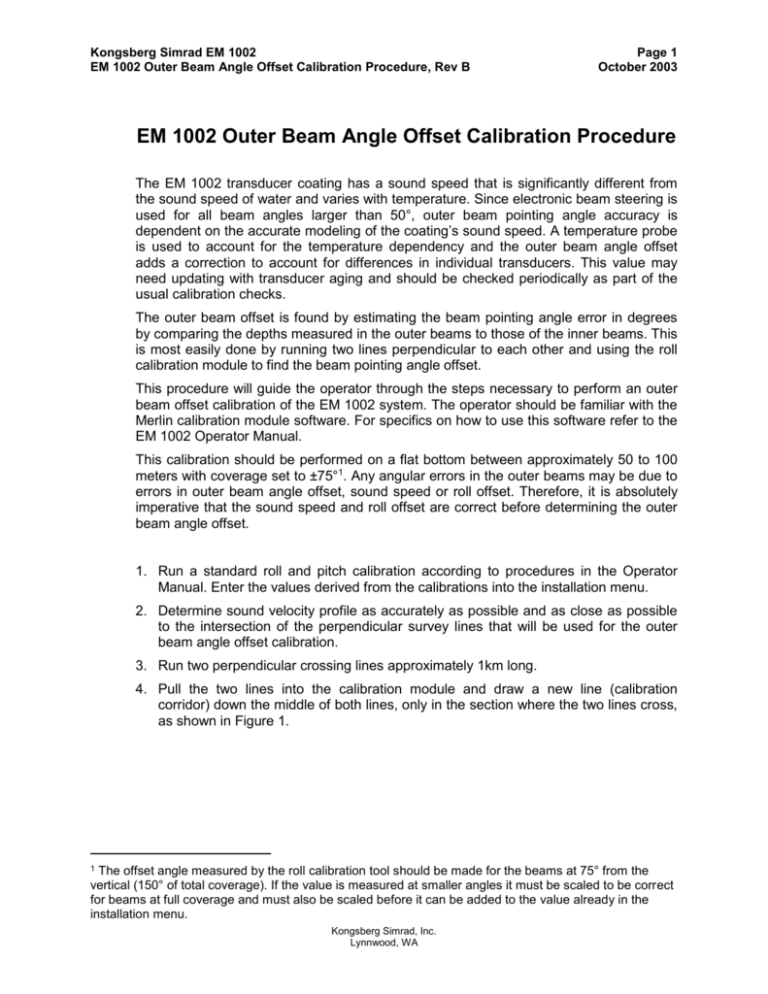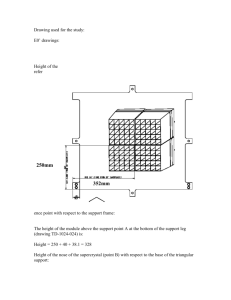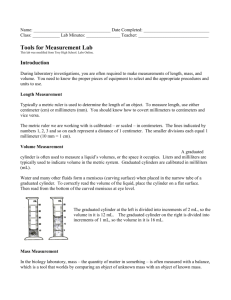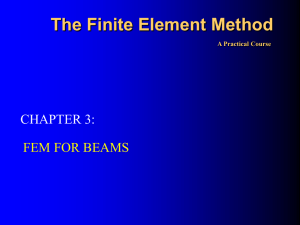EM1002 Outer Beam Angle Offset Calibration Procedure
advertisement

Kongsberg Simrad EM 1002 EM 1002 Outer Beam Angle Offset Calibration Procedure, Rev B Page 1 October 2003 EM 1002 Outer Beam Angle Offset Calibration Procedure The EM 1002 transducer coating has a sound speed that is significantly different from the sound speed of water and varies with temperature. Since electronic beam steering is used for all beam angles larger than 50°, outer beam pointing angle accuracy is dependent on the accurate modeling of the coating’s sound speed. A temperature probe is used to account for the temperature dependency and the outer beam angle offset adds a correction to account for differences in individual transducers. This value may need updating with transducer aging and should be checked periodically as part of the usual calibration checks. The outer beam offset is found by estimating the beam pointing angle error in degrees by comparing the depths measured in the outer beams to those of the inner beams. This is most easily done by running two lines perpendicular to each other and using the roll calibration module to find the beam pointing angle offset. This procedure will guide the operator through the steps necessary to perform an outer beam offset calibration of the EM 1002 system. The operator should be familiar with the Merlin calibration module software. For specifics on how to use this software refer to the EM 1002 Operator Manual. This calibration should be performed on a flat bottom between approximately 50 to 100 meters with coverage set to ±75°1. Any angular errors in the outer beams may be due to errors in outer beam angle offset, sound speed or roll offset. Therefore, it is absolutely imperative that the sound speed and roll offset are correct before determining the outer beam angle offset. 1. Run a standard roll and pitch calibration according to procedures in the Operator Manual. Enter the values derived from the calibrations into the installation menu. 2. Determine sound velocity profile as accurately as possible and as close as possible to the intersection of the perpendicular survey lines that will be used for the outer beam angle offset calibration. 3. Run two perpendicular crossing lines approximately 1km long. 4. Pull the two lines into the calibration module and draw a new line (calibration corridor) down the middle of both lines, only in the section where the two lines cross, as shown in Figure 1. 1 The offset angle measured by the roll calibration tool should be made for the beams at 75° from the vertical (150° of total coverage). If the value is measured at smaller angles it must be scaled to be correct for beams at full coverage and must also be scaled before it can be added to the value already in the installation menu. Kongsberg Simrad, Inc. Lynnwood, WA Page 2 October 2003 Kongsberg Simrad EM 1002 EM 1002 Outer Beam Angle Offset Calibration Procedure, Rev B Figure 1 Survey Line 1 Survey Line 2 Roll Calibration Corridor 1 Roll Calibration Corridor 2 5. Select roll cal. from the pull down menu and right click on one of the two new lines that were drawn in the calibrate module. When the roll calibrate module starts the operator should see a roll calibrate window similar to Figure 2 (Roll Calibration Corridor 2 shown). One line represents the middle beams and the other line represents the full swath. If the outer beams are too shallow (smile) compared to the center beams then the outer beam offset will be negative, if they are too deep (frown) then the outer beam offset will be positive2. For the example shown in Figure 2 the resulting outer beam offset angle will be a negative value. 2 The sign correction is the opposite of what is stated in the operator manual (Rev E) and opposite of software versions prior to 5.1u25. Simrad, Inc. Lynnwood, WA Kongsberg Simrad EM 1002 EM 1002 Outer Beam Angle Offset Calibration Procedure, Rev B Page 3 October 2003 Figure 2 Full Swath Line 1 Center Beams Line 2 6. Move the slider in the roll calibration window to align either the left or right side. See Figures 3 and 4. As with all calibrations, the final alignment is subjective, but remember that the objective is to align the outermost beams with the center beams. Any obvious outliers and noise should be ignored when performing the calibration. Record the values found from the left and right side of the swath as absolute values (no sign). Kongsberg Simrad, Inc. Lynnwood, WA Page 4 October 2003 Kongsberg Simrad EM 1002 EM 1002 Outer Beam Angle Offset Calibration Procedure, Rev B Figure 3 Figure 4 Simrad, Inc. Lynnwood, WA Kongsberg Simrad EM 1002 EM 1002 Outer Beam Angle Offset Calibration Procedure, Rev B Page 5 October 2003 7. Follow the same procedure on the second new line that was drawn in the calibrate window (Figure 1). See Figures 5 and 6 (Roll Calibrate Corridor 1 shown). Figure 5 Full Swath Line 2 Center Beams Line 2 Figure 6 Kongsberg Simrad, Inc. Lynnwood, WA Page 6 October 2003 Kongsberg Simrad EM 1002 EM 1002 Outer Beam Angle Offset Calibration Procedure, Rev B 8. Take the average of the four values found in steps 7 and 8, this is the outer beam offset angle correction. The sign is determined as discussed above. 9. Add the outer beam angle offset correction just determined to the outer beam angle offset already used in the installation menu to determine the final outer beam offset angle. This value is entered into the installation menu. 10. For the examples shown, the following four values were found: 0.12, 0.10, 0.04 and 0.06. The average of these four numbers is 0.08. Since the outer beams were shallower than the center beams (smile) the outer beam offset angle correction is -0.08°. If the value already in the installation menu when this calibration was performed is -0.01°, then the final value entered in the installation menu should be -0.09° 11. Repeat this procedure as verification on a new set of crossing lines. NOTE FOR SOFTWARE VERSION 5.2u1 AND HIGHER If the angular correction needed for the EM 1002 outer beams is more than 0.4 degrees, an extra calibration file should be installed. A default file named: Default_calib_em1002.txt located on the CD in the directory: CD/vxw/bsp_1002 is included on the CD (SW version 5_2u1 or higher) together with the BSP software. This file must be copied to a text file named: calib.txt and placed in the directory: /opt/simrad/bin/vxw/bsp_1002 Then the TRU must be rebooted and a new outer beam calibration done. Simrad, Inc. Lynnwood, WA








